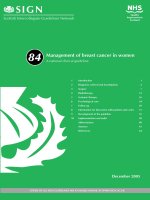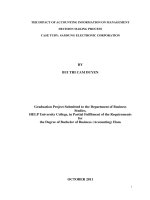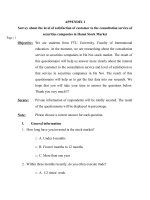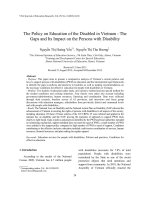Management of market risk, case study of modelling volatility in vietnam stock market
Bạn đang xem bản rút gọn của tài liệu. Xem và tải ngay bản đầy đủ của tài liệu tại đây (1.25 MB, 97 trang )
MINISTRY OF EDUCATION AND TRAINING
UNIVERSITY OF ECONOMICS HO CHI MINH CITY
MASTER OF BUSINESS ADMINISTRATION
MANAGEMENT OF MARKET RISK:
CASE STUDY OF MODELLING VOLATILITY
IN VIETNAM STOCK MARKET
BY
LAM VAN BAO DAN
HO CHI MINH CITY – 2012
MINISTRY OF EDUCATION AND TRAINING
UNIVERSITY OF ECONOMICS HO CHI MINH CITY
FALCULTY OF BUSINESS ADMINISTRATION
MASTER OF BUSINESS ADMINISTRATION
MANAGEMENT OF MARKET RISK:
CASE STUDY OF MODELLING VOLATILITY
IN VIETNAM STOCK MARKET
BY
LAM VAN BAO DAN
SUPERVISOR
VO XUAN VINH
2012
A thesis submitted in partial fulfillment of the requirements for
the degree of Master of Business Administration
Master of Business Administration
Lam Van Bao Dan
CERTIFICATION
“I certify that the substance of this thesis has not already been submitted for any degree
and is not being currently submitted for any other degree.
I certify that, to the best of my knowledge, any help received in preparing this thesis,
and all sources used have been acknowledged in this thesis”
LAM VAN BAO DAN
th
Date: 25 April, 2012
K17-EMBA
Page 2
2012
Master of Business Administration
Lam Van Bao Dan
Abstract
The thesis concerns with market risk management. It has implications for businesses and
investors, especially those hold investment in stocks. In particular, the thesis investigates
the technique to model stock volatility in Vietnam stock market.
The rapid growth of Vietnam stock market recently has received a great attraction of
local and global investors. However, like other emerging stock markets, this growth has
accompanied with high risk. Over the past thirty years, a huge number of articles have
discussed the volatility of stock returns in developed and emerging capital markets.
Unfortunately, even though Vietnam stock market has started trading from 2000, there
has been relatively little work done on modelling and forecasting the return volatility in
Vietnam stock market.
This thesis employ the GARCH type models, both symmetric and asymmetric including
ARCH (1), GARCH (1,1), GARCH-M (1,1), EGARCH (1,1) and TGARCH (1,1) to
examine the sufficient models for capturing the characteristics of the return volatility in
Vietnam stock market. The data set of VN-Index over nine year period from March,
2002 to December, 2011 which divided into four periods including before crisis, crisis,
recovering and whole period. The findings suggest the sufficiency of ARCH (1),
GARCH (1,1) and GARCH-M (1,1) models in capturing properties of conditional
variance in Vietnam stock market. The results also provide the indicator of the riskreward relationship and show the weak evidence of asymmetry in the return series in
Vietnam stock market.
K17-EMBA
Page 3
2012
Master of Business Administration
Lam Van Bao Dan
Table of Contents
Page
I.
INTRODUCTION .............................................................................................................
8
1.1
Background of the Thesis....................................................................................................
8
1.2
Research Questions and Objectives ..................................................................................
11
1.2.1 Research Questions .............................................................................................
11
1.2.2 Research Objectives and Implications ...............................................................
11
Vietnam Stock Market Overview .....................................................................................
11
1.3.1 Introduction .........................................................................................................
11
1.3.2 VN-Index .............................................................................................................
16
1.4
Outline of the Thesis .........................................................................................................
20
II.
LITERATURE REVIEW...............................................................................................
21
2.1
Volatility Definition ..........................................................................................................
21
2.2
The Characteristics of Volatility in Financial Market .....................................................
22
2.3
Literature Review ..............................................................................................................
23
III.
DATA AND METHODOLOGY ...................................................................................
35
3.1
Data ..................................................................................................................................
35
3.2
Descriptive Statistics .........................................................................................................
37
3.2.1 Histogram and Statistics Definition ...................................................................
37
3.2.2 Descriptive Statistics of Return Series for the Period before Crisis ................
39
3.2.3 Descriptive Statistics of Return Series for Crisis Period ..................................
40
3.2.4 Descriptive Statistics of Return Series for Recovering Period ........................
41
3.2.5 Descriptive Statistics of Return Series for the Whole Period ..........................
42
3.2.6 Conclusions .........................................................................................................
43
Methodology ......................................................................................................................
44
3.3.2 Testing for ARCH Effects ..................................................................................
45
3.3.3 GARCH Models ..................................................................................................
46
1.3
3.3
K17-EMBA
Page 4
2012
Master of Business Administration
Lam Van Bao Dan
IV.
4.1
EMPIRICAL RESULTS ................................................................................................ 53
Testing for ARCH Effect .................................................................................................. 53
4.2
Empirical Results of Different Periods ............................................................................ 54
4.2.1
Empirical Results of the Period before Crisis ................................................... 54
4.2.2
Empirical Results of the Crisis Period ............................................................... 57
4.2.3
Empirical Results of the Recovering Period ..................................................... 58
4.2.4
Empirical Results of the Whole Period of Vietnam Stock Market .................. 59
V.
5.1
SUMMARY AND IMPLICATIONS............................................................................ 62
Summary and Implications ............................................................................................... 62
5.2
Limitations and Recommendations for Further Research ............................................... 63
VI.
APPENDIX ....................................................................................................................... 65
6.1
Appendix-1: Testing for ARCH Effect ............................................................................ 65
6.2
6.1.1
Before Crisis Period (From March, 2002 to December, 2007) ........................ 65
6.1.2
Crisis Period (From January, 2008 to December, 2009) .................................. 66
6.1.3
Recovering Period (From January, 2010 to December, 2011) ......................... 67
6.1.4
Whole Period (From March, 2002 to December, 2011) ................................... 68
Appendix-2: GARCH Models Analysis ........................................................................... 69
6.2.1
Before Crisis Period (From March, 2002 to December, 2007) ........................ 69
6.2.2
Crisis Period (From January, 2008 to December, 2009) .................................. 74
6.2.3
Recovering Period (From January, 2010 to December, 2011) ......................... 79
6.2.4
Whole Period (From March, 2002 to December, 2011) ................................... 84
REFERENCES............................................................................................................................. 89
K17-EMBA
Page 5
2012
Master of Business Administration
Lam Van Bao Dan
List of Tables
Table No.
Description
Page
Table 1
Price limitations in HOSE over different periods
16
Table 2
Summary for estimation results of before crisis period
60
Table 3
Summary for estimation results of crisis period
60
Table 4
Summary for estimation results of recovering period
61
Table 5
Summary for estimation results of whole period
61
List of Figures
Figure No.
Description
Page
Figure 1
Number of listed company from 2000 to 2011
14
Figure 2
Market capitalization from 2000 to 2011
14
Figure 3
Number of securities companies from 2000 to 2011
15
Figure 4
Number of trading accounts from 2000 to 2011
15
Figure 5
Performance of VN-Index from 2000 to 2011
17
Figure 6
Performance of VN-Index in 2007
18
Figure 7
Performance of VN-Index in 2009
18
Figure 8
Histogram of daily return series of VN-Index
(01/03/2002 – 28/12/2007)
40
Figure 9
Histogram of daily return series of VN-Index
(02/01/2008 – 31/12/2009)
Histogram of daily return series of VN-Index
(04/01/2010 – 30/12/2011)
Histogram of daily return series of VN-Index
(01/03/2002 – 30/12/2011)
41
Figure 10
Figure 11
K17-EMBA
Page 6
42
43
2012
Master of Business Administration
Lam Van Bao Dan
Acknowledgement
I would like to say special thanks to my supervisor, Dr. Vo Xuan Vinh for his helpful
directions, encouragements and valuable comments in preparing this thesis.
I would like to thank all lecturers in EMBA program, especially to Dr. Tran Ha Minh
Quan for his help.
I would also like to thank all my friends in the program for supporting and encouraging
me to finish this thesis.
Finally, special thanks also go to my wife and my family for their love and staying
beside me during my study.
K17-EMBA
Page 7
2012
Master of Business Administration
I.
INTRODUCTION
1.1
Background of the Thesis
Lam Van Bao Dan
Investing in emerging stock markets can make a large return but also creates a big loss
for businesses because of high volatility (high risk). Therefore, finding a technique to
model volatility is important for businesses and investors investing in stock market. This
thesis will investigate the volatility models which best fits the Vietnam stock market
conditions. Modelling volatility will help businesses and investors understand and better
manage risks involved in their investment.
Volatility is more and more important in financial market. There are a huge number of
researches and discussions for volatility in the past thirty years and especially in the
recent years. This is because volatility is a special indicator in financial market. It is a
key factor in many securities pricing formula as well as the value-at-risk models.
Even though volatility is unobservable, it plays an important role in making investment
decision. On the other hand, it is also the interest of the policy makers in financial
markets. The policy makers are interested in the impact of volatility on the stability of
the financial market and hence on the economy.
Because of the above implications, volatility is the focus of several studies for
estimation and forecast. The volatility index (VIX) and Nasdaq Volatility Index (VXN)
that defined as a weighted of prices for a range of options on the S&P 500 index and the
Nasdaq 100 index have started trading from 2006. It is calculated in real time by
Chicago Board Option Exchange (CBOE). These are two of the world’s most popular
index of investors concerning to future stock market volatility. The goal is to estimate
the implied volatility of the stock market over the next 30 days. It is proven that the low
volatility index, the high trader confidence.
There are a lot of models that can be implied for modelling and forecasting volatility
including ARCH/GARCH models and non-GARCH models. However, ARCH model
K17-EMBA
Page 8
2012
Master of Business Administration
Lam Van Bao Dan
proposed by Engle (1982) and generalized by Bollerslev (1986) are said to be most
sufficient for capturing the characteristics of the time varying stock return volatility.
From the introduction of the GARCH model, a huge number of GARCH extensions or
GARCH family such as GARCH in mean (GARCH-M) (Bollerslev, 1986), EGARCH
(Nelson, 1991), Threshold GARCH (TGARCH) (Glosten, Jagannathan and Runkle,
1993), Asymmetric GARCH model (AGARCH) (Engle, 1990), etc. have been studied
and proven to be sufficient for modelling and forecasting stock return volatility.
However, different papers support different models and show the conflicts in
implication. The empirical results argue that different models are suitable for different
markets and in different time periods.
Therefore, we will employ several widely accepted GARCH models including ARCH,
GARCH, GARCH-M, TGARCH and EGARCH to investigate the volatility of Vietnam
stock market in this thesis. From the results of the study, we will suggest the sufficient
GARCH models for capturing the properties of return volatility in Vietnam stock
market.
There have been numerous researches focusing on modelling stock price volatility.
However, most of them have discussed about the developed capital markets. The
emerging markets have not received much attention. Recently, the emerging markets,
especially the fast development countries such as China, Brazil, India, Russia, Mexico
and the ASEAN countries has increasingly attracted the investors to diversify their
portfolios.
Vietnam stock market has just been traded more than ten years. It has significantly
developed in recent years and has received a great attraction of many investors, both
local and foreign. They made considerable amount of profits during the boom time of
2006-2007. However, the market went down in 2008 and 2009 due to the effect of world
financial crisis that results in a big loss for many businesses and investors.
K17-EMBA
Page 9
2012
Master of Business Administration
Lam Van Bao Dan
Comparing with the other stock markets in the region, Vietnam stock market is a small
and young market. It has the typical characteristics of the young emerging financial
market such as illiquidity of stock, incomplete legal system, unstable investors and
sensitive to financial shocks. It is a promising stock market but requires high risk
management technique to avoid the unexpected shocks.
The data set to be used in this thesis is the daily VN-Index of Ho Chi Minh City stock
exchange (HOSE). The sufficient source of data is received from the data base of
Vietnam stock market news and information official website (www.vietstock.vn) and
Vietcombank Securities Company Ltd. (www.vcbs.com.vn). The time period of the data
set is from March, 2002 to December, 2011 which is the time of this study. The reason
for choosing the data set from March, 2002 instead of July, 2000 (starting time of
trading of Ho Chi Minh City Securities Trading Center (HOSTC)) is that there were
only three trading days per week before March, 2002.
The world financial crisis in 2008 and 2009 has negative impacted on the stock markets
around the world and Vietnam is one of the most critical impacted countries. The impact
of the crisis to Vietnam stock market was clearly reflected on the VN-Index of Ho Chi
Minh City Stock Exchange. The VN-Index went down unbreakable from 1,002.7 on 15
th
th
November, 2007 to the bottom of 235.5 on 24 February, 2009. Even though the VNIndex has recovered from the end of 2009 but it has not reached to haft of the peak value
th
at 1,170.68 on 12 March, 2007. To provide a more accuracy analysis, the data set will
be splitted into four periods including before 2008 (before crisis period), from 2008 to
2009 (crisis period), from 2010 to 2011 (recovering period) and from 2002 to 2011
(whole period of Vietnam stock market). We will examine whether the applied GARCH
models are sufficient for Vietnam stock market in different periods.
K17-EMBA
Page 10
2012
Master of Business Administration
1.2
Lam Van Bao Dan
Research Questions and Objectives
1.2.1 Research Questions
The thesis will study the stock return volatility in Vietnam stock market by employing
different ARCH/GARCH models, both symmetric and asymmetric specifications
including ARCH, GARCH, GARCH-M, TGARCH and EGARCH. Based on the
problem statement and background of the study, the key questions of this thesis need to
be answered are as follows:
What are the best fit models among the employed ARCH/GARCH models for
forecasting and estimating the volatility of Vietnam stock market?
The second question is that what is the predictable risk in Vietnam stock market
based on the estimation results?
1.2.2 Research Objectives and Implications
To answer the above questions, the main objectives of the thesis are to describe the
market risk in different periods and examine the predictability of the return volatility in
Vietnam stock market across the alternative employed GARCH models.
The implications of the thesis are to provide the management technique for market risk
in Vietnam stock market for businesses and investors and suggest the best fit models for
forecasting and estimating the stock return volatility quantitatively. On the other hand,
the empirical results contribute to the literature of Vietnam financial market analysis for
academy, policy making and investment.
1.3
Vietnam Stock Market Overview
1.3.1 Introduction
From the renovation time in the end of 1980s, there were the ideas and discussions for
establishment of official securities market in Vietnam to meet the requirement of market
economy and to create a new channel of fund raising for development and
K17-EMBA
Page 11
2012
Master of Business Administration
Lam Van Bao Dan
investment. Therefore, the project of research and establishment of the securities market
was then participated by a number of government agencies and institutes, the results of
which were later submitted to the Government. As the request and authorization of the
Government, the State Bank of Vietnam (SBV) together with the Ministry of Finance to
carry out their researches of the issues relevant to the operation of the securities market,
propose the suitable model for Vietnam’s securities market, provide part of the future
regulatory staff with basic training in securities and securities market, study the actual
operations of some securities markets in the region and in the world, etc.
On 28
th
November, 1996, the State Securities Commission of Vietnam (SSC) was
established under the Government’s Decree No. 75/CP. This is the first step and the
foundation of Vietnam stock market. SSC is the governmental agency with the mission
of organizing and regulating the operations in the field of stock and stock market in
Vietnam. SSC plays a decisive role in preparing necessary conditions for setup of the
stock market. Its major task is to organize and regulate the stock and stock market
operations, with the focal mission of facilitating the process of fund mobilization for
development investment, ensuring the orderly, safe, transparent, equitable and efficient
operation of the stock market, and more important, protecting investors’ legitimate
rights and interests.
SSC decided Bank of Investment and Development of Vietnam (BIDV), one of the
biggest state-owned commercial banks in Vietnam as the designated settlement bank of
Stock Trading Center. BIDV is in charge of making credit and debit balance payments of
all securities transactions. Several other domestic banks and securities companies have
been authorized to accept custody of securities, with HSBC, Standard Chartered bank
and Deutsche bank Ho Chi Minh City branches currently the only banks providing
custody services for foreign investors. Custody is based on a central depository, central
registry book entry system. Currently, there are five banks including
K17-EMBA
Page 12
2012
Master of Business Administration
Lam Van Bao Dan
two local banks and three foreign banks and thirteen licensed securities companies. Of
these, nine have been licensed to conduct a full range of securities services including
underwriting, brokerage, custody, research, portfolio management and trading.
Four years later, the first official stock exchange market was launched in Ho Chi Minh
City so call Ho Chi Minh City Securities Trading Center (HOSTC), opening the first
pages of Vietnam stock market. Right after launching, HOSTC started trading the first
th
time on 28 July, 2000 with two listed companies those are Refrigeration Electrical
Engineering Joint Stock Corporation (REE) and Saigon Cable and Telecommunication Material
Joint Stock Company (SAM) with the total capitalization of $16.87 million. After five
years operation of HOSTC, the second securities trading center (HASTC) started trading
in Ha Noi. In August, 2007 the securities trading centers were renamed and upgraded to
stock exchange as Ho Chi Minh City stock exchange (HOSE) and Ha Noi stock
exchange (HNX). After eleven years of development, even critically impacted by the
world financial crisis in 2008 and 2009, it has been witnessed the great development of
Vietnam stock market, especially the booming time in 2006 and 2007. Vietnam stock
market now operates with 774 listed companies in both HOSE and HNX. The current
market capitalization of approximately $55.68 billion equal to 48% of the country’s
GDP. The market capitalization represents about 43% of the country’s GDP in 2007
which almost double the amount in 2006 (22.7%). However, the financial crisis in 2008
has seriously impacted on Vietnam stock market and led to the drop of market
capitalization to below 20% of the country’s GDP. In 2009, together with the recovery
of the world economy, the market capitalization of Vietnam stock market rapidly
increased to nearly 38% of the GDP by end of 2009 and reached to 48% of the GDP by
end of 2011. It is expected to be around 80% to 110% of the country’s GDP in 2020.
The number of securities companies and trading account rapidly increase. There were
only three securities companies at the end of 2000 but it has rapidly increased to 105
K17-EMBA
Page 13
2012
Master of Business Administration
Lam Van Bao Dan
securities companies at the end of 2011. The number of trading accounts are also
witnessed the impressing increase from around 3,000 trading accounts at the end of
2000 to more than one million trading accounts at the end of 2011.
Figure 1 to 4 show the number of listed companies, market capitalization, number of
securities companies and number of trading accounts respectively in Vietnam stock
market from July, 2000 to December, 2011.
Figure 1: Number of listed companies from 2000 to 2011
Figure 2: Market capitalization from 2000 to 2011
K17-EMBA
Page 14
2012
Master of Business Administration
Lam Van Bao Dan
Figure 3: Number of securities companies from 2000 to 2011
Figure 4: Number of trading accounts from 2000 to 2011
At the beginning, an overall foreign ownership limit of 20% for stocks and 40% for
bonds were implemented. In July, 2003, in an effort to improve liquidity for the stock
market, the government raised the foreign ownership limit for stock to 30% and totally
K17-EMBA
Page 15
2012
Master of Business Administration
Lam Van Bao Dan
removed foreign ownership limit of a particular issuer’s bonds. However, foreign
investors on the Stock Trading Center of Vietnam must register through a custodian
licensed to hold securities on behalf of the investors. Once registered, a securities
transaction code is issued to the foreign investor that will permit securities trading.
The automatic order-matching system is applied for operation on Vietnam stock market.
The system operated based on the computerized order process following time and price
priority. The system capacity is 300,000 orders per day. There were only two trading
sessions per day before June, 2006. It was increased to three trading sessions per day
then after.
Similar to the other young emerging stock markets, Vietnam stock market is small, high
volatility, and herb behavior reaction. The authority has set the daily price limit
regulation for all stock traded on HOSTC from the beginning stage. However, the price
limitation is not always fixed. It has been adjusted several times to meet the
requirements and adapt to the situation changes. The price limitations in HOSE over
different periods are shown in table 1 below.
Table 1: Price limitations in HOSE over different periods
Period
Price limitations
28/07/2000 – 31/07/2002
2%
01/08/2002 – 31/12/2002
3%
01/01/2003 – up to date of the study
5%
1.3.2 VN-Index
The VN-Index presents the stock price index of Ho Chi Minh Securities Trading Center
(HOSTC). It is the value-weighted stock price of all common stocks traded on the
HOSTC. Base on this index, the investors can evaluate and analyze the Vietnam stock
market in general to make the investment decision.
K17-EMBA
Page 16
2012
Master of Business Administration
Lam Van Bao Dan
The VN-Index is computed by comparing the current market value with the base value
th
that was started as 100 points on the first trading day of HOSTC on 28 July, 2000. The
base value will be adjusted in the following cases: a) new listed; b) stopped trading; c)
changing of market capitalization.
The Figure 5 describes the performance of VN-Index over the past eleven years. In
general, the VN-Index series has upward trend from the end of 2000 to the end of 2007
but has downward trend in 2008 and 2009. Even it has recovered from the end of 2009
but it is still highly fluctuated and has never reached the peak value of March, 2007.
Figure 5: Performance of VN-Index from 2000 to 2011
1,200
1,000
800
600
400
200
250
2001
0
2000
K17-EMBA
Page 17
2012
Master of Business Administration
Lam Van Bao Dan
Figure 6: Performance of VN-Index in 2007
Figure 7: Performance of VN-Index in 2009
Source: State Securities Commission
It can be said that the Vietnam stock market started slowly. The VN-Index moved up and
down but not significant changed during the first 5 years. Vietnam stock market
K17-EMBA
Page 18
2012
Master of Business Administration
Lam Van Bao Dan
rapidly developed in 2006 and really boomed in the year 2007. The number of new
listed companies, amount of market capitalization, VN-Index and trading volumes
significant increased this time. As a result, the VN-Index hit the recorded high at
1170.67 in March, 2007.
The years 2008 and 2009 were the crisis time of Vietnam stock market. The world
financial crisis has seriously impacted on Vietnam stock market. The investors run away
and the VN-Index recorded the loss of approximately 80% to the bottom at 235.5 in
February, 2009. It was even worse in Ha Noi stock exchange that the HNX Index
dropped below the starting point of 100. Fortunately, the recovery of the world economy
from end of 2009 has pulled the Vietnam stock market turning back. However, the
growth of Vietnam stock market has not been steady and accompanied with many
unforeseen risks. The fluctuation in VN-Index values can be explained as the
unstableness of the macroeconomics of Vietnam and the unbalance of supply and
demand in the market.
Vietnam stock market is a young market with the typical characteristics of emerging
market such as high volatility, illiquidity, incomplete legal system, unstable investors
and sensitive to financial shocks. Compared with the other Asian capital markets,
Vietnam stock market can be seen as the smallest and the most illiquid market but it has
been considered as rapidly increasing, high potential and fruitful market. It has recently
received a great attraction of the local and foreign investors. However, this rapid growth
has been accompanied with high risk. Market risk management and volatility forecast
are not an easy task for the businesses and investors in the stock market. Over the past
thirty years, a huge number of articles have discussed about volatility of stock returns of
the capital markets around the world. Unfortunately, there has been relatively little work
done on modelling and forecasting stock return volatility in Vietnam stock market.
K17-EMBA
Page 19
2012
Master of Business Administration
1.4
Lam Van Bao Dan
Outline of the Thesis
The thesis includes five sections and is organised as follows:
Section 1 briefly introduces background of the stock volatility and the objectives of the
thesis. This section also provides an overview of Vietnam stock market including the
development of Vietnam stock market and the market index.
The second section reviews the previous study in modelling stock return volatility as
well as presents the volatility definition and its characteristics.
Section 3 describes the data and the descriptive characteristics of the data set. This
section discusses the research methodology for testing the ARCH effects the data set and
introduces the ARCH/GRACH family for modelling the stock return volatility.
Section 4 illustrates the empirical results and explains the key points of the analysis by
GARCH models in modelling volatility of Vietnam stock market.
Section 5 summarizes the findings and the implications of the thesis. This section also
provides the paper’s limitations and recommendations for future research possibilities.
K17-EMBA
Page 20
2012
Master of Business Administration
II.
LITERATURE REVIEW
2.1
Volatility Definition
Lam Van Bao Dan
Stock price volatility is the relative rate at which the price of a securities moves up and
down. The volatility of stock price can be seen by looking at the range between lowest
and highest price over time periods. The greater the difference is, the more volatile the
price. The stock price volatility is computed by the conditional variance of standard
2
deviation of daily change in price (Pagan and Schwert, 1990).
Statistically, the volatility is often measured as the conditional variance as the below equation:
1
2
2
n
Ri
n 1i1
Where, R is the return and μ is the mean return.
The standard deviation is able to be computed from any distribution. The probability can
only be statistical meaningful if comes with a distribution such as normal distribution or
t-distribution. The volatility is used to measure the risk of financial figures over the time
period.
The daily return of the stock price at the time t is computed that:
Rt = Log
P
2
t
~
P
2
xT ,
T
t1
Where, Rt is the daily return of stock price and Pt is the stock price at time t.
It can be said that stock price volatility plays an important role in decision on stock price
option. When the stock price volatility increases, the stock price will move farther away
from the strike price.
K17-EMBA
Page 21
2012
Master of Business Administration
2.2
Lam Van Bao Dan
The Characteristics of Volatility in Financial Market
According to several empirical researches, the financial market volatility has some of
following features that make it be a risk measure factor in many value-at risk models
even though it is unobservable directly.
The first feature is the clustering of volatility or volatility persistence. There are the
evidences that the changes of the stock price followed by the other changes. It means
that large changes in the price of stock are often followed by other large changes, and
small changes are often followed by small changes (Engle and Patton, 2001). This
behavior has been reported by several other studies, such as Fama (1965), Chou (1988),
Schwert (1989) and Baillie et al. (1996). The implication of such volatility clustering is
that volatility shocks today will influence the expectation of volatility many periods in
the future. This feature can be applied to forecast the future volatility in the financial
market. The future volatility can be predicted by the current and past volatility. Volatility
is said to be persistent if today’s return has a large effect on the forecast variance many
periods in the future.
The second characteristic is mean reversion of volatility. The volatility reversion said
that the volatility changes following the past values. It means that a high volatility
period will lead to the normal volatility period and vice versa, a low volatility period
will create the way for rising of volatility. In general, a normal level of volatility will be
returned eventually or it is statistically stability. A long term forecast will take into
account this feature of volatility that the volatility will be come back to normal level
from whichever they are. This characteristic is also supported by the work of Tsay
(2005) in the book of analysis of financial time series.
Another feature is the asymmetric effect of positive and negative shocks. This feature
sometimes described as leverage effect or risk premium effect. In the volatility theory,
when the price of stock falls, the volatility of stock will increase. The negative shocks
will increase the volatility and then reduce the demand of stock and similarly the
K17-EMBA
Page 22
2012
Master of Business Administration
Lam Van Bao Dan
positive news will reduce the volatility and then increase the demand of stock. As a
result, the stock value followed by the increased or decreased volatility can be predicted
by the news. The evidence is also found by the studies of Nelson (1991), Glosten et al.
(1993) and Engle and Ng (1993).
According to the result of several researches, the volatility of stock return series is not
constant over time. It is different with the assumption in the traditional value-at-risk
models that the volatility was assumed to be constant over time. This feature is
important in selection of the sufficient models for modelling stock return volatility.
Last but not least, it is found in some empirical studies such as King and Wadhwani
(1990), Pan et al. (1999) and Abidin and Zhang (2011) that the volatility spillover
between the international stock markets. In addition, the correlation among the volatility
of stock return seems to be stronger than the stock return itself. This especially found
during the time of financial crisis, for example the global financial crash in 1987,
financial crisis in Southeast Asia in 1997 and the recent global financial crisis in 2008.
2.3
Literature Review
Several value-at-risk models listed in the previous studies were proven to be sufficient
for modelling the stock price volatility such as Exponentially Weighted Moving Average
(EWMA), ARCH/GARCH family, Stochastic Volatility (SV). On the other hand,
different models support different markets and in different time period. Among these
models, ARCH/GARCH type models are the most widely used models for estimating
and forecasting stock return volatility in the previous studies for both mature and
emerging markets. In this thesis, thus we just focus on the ARCH/GARCH type models
for estimating and forecasting the volatility of Vietnam stock market.
The purpose of this part of the thesis is to review various ARCH/GARCH family models
that used to apply for forecasting and estimating the volatility of stock market.
K17-EMBA
Page 23
2012









